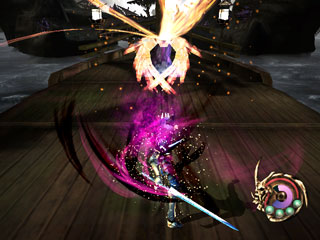
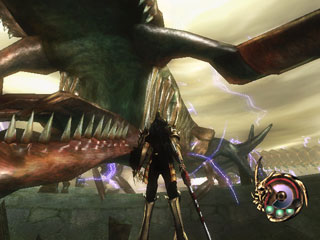
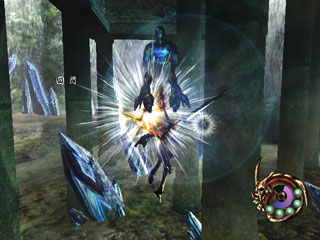
Otogi: Myth of Demons for the Xbox is a beautifully designed action packed
adventure through the underworld of Japanese Mythology. Otogi casts you as an
undead warrior named Raikoh who battles against an endless army of demonic foes.
You can use a variety of upgradeable weapons and magic spells to destroy them
and purify the world. Otogi's level designs are brilliant and the gameplay is
intense with lots of action bracketed by an engaging storyline. The biggest
problem with the game is its high level of difficultly, thanks mostly to its
frustrating camera system. However, the game transcends its flaws and creates a
brilliant experience.
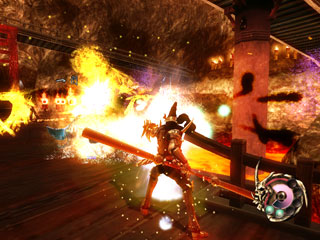 Developed
by From Software and published by Sega, Otogi: Myth of Demons is brilliant game
set in Feudal Japan. As the game begins, a mysterious princess resurrects the
protagonist Raikoh, a skilled samurai warrior who's caught in a netherworld
between life and death. She has given him an opportunity to rise from his grave
because much of the world has been destroyed by demonic forces. These forces
have unleashed waves of destruction and death after the Great Seal that protects
the world was broken, and it's up to Raikoh to rid the world of their dark
plague. Raikoh was an assassin in his previous life, but he's been given a
second chance to purify himself and atone for those sins. The princess has also
granted Raikoh a variety of supernatural powers including the ability to jump
incredibly high, use mystical swords plus Raikoh has limited invisibility during
dashes. After the first few levels, Raikoh can also equip and use a variety of
magic spells on the demons. This is a third-person action adventure title that
offers many battles against undead foes but also offers some interesting RPG
style elements, since you can upgrade Raikoh's weapons and abilities as you
complete levels. This definitely makes for a more interesting game with more
depth than you'd initially expect. Also adding more depth than one would
normally expect in this type of game is the evocative plot. It unfolds at a good
pace throughout with cinemas and in-game voice-overs that effectively immerse
you into the story.
Developed
by From Software and published by Sega, Otogi: Myth of Demons is brilliant game
set in Feudal Japan. As the game begins, a mysterious princess resurrects the
protagonist Raikoh, a skilled samurai warrior who's caught in a netherworld
between life and death. She has given him an opportunity to rise from his grave
because much of the world has been destroyed by demonic forces. These forces
have unleashed waves of destruction and death after the Great Seal that protects
the world was broken, and it's up to Raikoh to rid the world of their dark
plague. Raikoh was an assassin in his previous life, but he's been given a
second chance to purify himself and atone for those sins. The princess has also
granted Raikoh a variety of supernatural powers including the ability to jump
incredibly high, use mystical swords plus Raikoh has limited invisibility during
dashes. After the first few levels, Raikoh can also equip and use a variety of
magic spells on the demons. This is a third-person action adventure title that
offers many battles against undead foes but also offers some interesting RPG
style elements, since you can upgrade Raikoh's weapons and abilities as you
complete levels. This definitely makes for a more interesting game with more
depth than you'd initially expect. Also adding more depth than one would
normally expect in this type of game is the evocative plot. It unfolds at a good
pace throughout with cinemas and in-game voice-overs that effectively immerse
you into the story.
The gameplay is quite intense with expansive
level designs. You'll frequently face multiple enemies, who can come at you
either on the ground or in the air. They attack Raikoh at the same time, but he
can use his special dash move to get out of the way quickly. Facing these
attackers can pose quite a challenge, but Raikoh has some amazing abilities to
use. He has two different sword attacks. The normal attack releases a quick
burst of shots and is more effective in close combat, while the other is a
larger slower attack that's useful against powerful enemies. Raikoh can also use
this attack to destroy objects such as buildings and temples. It's difficult to
keep track of all the foes onscreen, but you don't always have to destroy every
enemy on a level to proceed. Additionally, you can auto-target foes to focus his
attacks. As he defeats enemies, they release energy that Raikoh can capture and
use himself. His energy levels are divided into two separate gauges. One shows
his main energy, while the other is displays how much magic energy he has. These
gauges can be replenished in a number of ways. The life guage slowly regains its
strength after you've been hit, meaning you can replay the game. You can also
increase your life by destroying enemies and sucking up their spirit forces, or
by finding orbs that are hidden through the game.
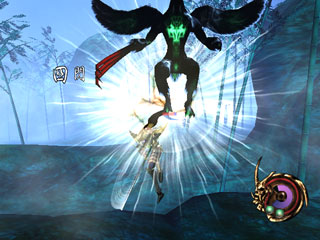 While
the game mechanics are similar to Devil May Cry, Otogi's a little bit more
cerebral and slower paced with a uniquely Eastern influences give it a
personality all its own. The level designs also offer some variety and you won't
always be doing the same things. For example, you may have to kill most of the
enemies in one level, while in another, you have to destroy a certain number of
objects in order to release a seal and proceed. Another key to the game's
long-lasting appeal are the enemies including flying skulls, skeleton warriors,
undead zombies and mystical beasts. Each of these has a unique attack pattern
and level of difficulty and you can't take them lightly. Some can attack you
from afar, while others only become dangerous in close proximity. Raikoh will
face many different types enemies in each level, which keeps the challenge level
high. In addition to standard enemies, there are also several confrontations
with elaborate bosses. These battles are even harder than the main levels, much
harder in fact. They'll probably take multiple attempts to beat, even for good
players.
While
the game mechanics are similar to Devil May Cry, Otogi's a little bit more
cerebral and slower paced with a uniquely Eastern influences give it a
personality all its own. The level designs also offer some variety and you won't
always be doing the same things. For example, you may have to kill most of the
enemies in one level, while in another, you have to destroy a certain number of
objects in order to release a seal and proceed. Another key to the game's
long-lasting appeal are the enemies including flying skulls, skeleton warriors,
undead zombies and mystical beasts. Each of these has a unique attack pattern
and level of difficulty and you can't take them lightly. Some can attack you
from afar, while others only become dangerous in close proximity. Raikoh will
face many different types enemies in each level, which keeps the challenge level
high. In addition to standard enemies, there are also several confrontations
with elaborate bosses. These battles are even harder than the main levels, much
harder in fact. They'll probably take multiple attempts to beat, even for good
players.
Another appealing aspect of the game is that
unlike many other platform adventures, Raikoh evolves over time, gaining new
abilities, weapons and magic spells. Players can also earn special accessories
that they can use in battle as well as customize their weapons and spells, which
gives Otogi a surprising amount of depth. There are more than 30 unique weapons,
many different kinds of spells 10 extra 'accessory' items that can be used in
your battles. Part of the enjoyment comes in figuring out which of these will be
the most effective. This lends the game a lot While the high degree of
difficulty will doubtless challenge players, it can also be needlessly
frustrating at certain points. There are many areas that seem impossible to get
through and you'll still restart levels multiple times, and repeatedly going
through the same level can become tedious. However, persistent players can
eventually progress through using skill and patience. A good strategy occurs
when you get stuck, is to change your weapons and spells. While this isn't a
panacea for every situation, its definitely worth a shot.
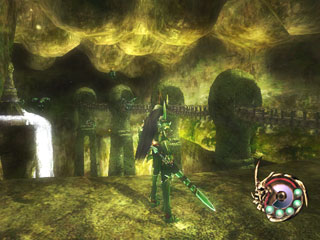 Another
frustrating aspect of Otogi's is the disappointingly awkward camera system,
which often gets in the way of the action and makes it difficult to see where
Raikoh is. While this isn't too noticeable when you're simply moving around the
level, you'll find yourself looking at a large wall that obscures the action far
too frequently during battles, or misjudging jumps and plunging to your death.
The camera angles can be quite intrusive at points, leaving you vulnerable at
critical points due to poor angles. This is especially aggravating when you're
on a narrow path and fall off because you can't see where the ledge is. The
default camera angles aren't as smooth as they could be, and adjusting the
viewpoint manually during heavy encounters isn't the best solution. While you
can use the auto-targeting system to mitigate this to some degree, it isn't a
perfect solution because it doesn't always lock onto the most dangerous enemies.
While it's problematic, it doesn't ruin the game. These problems persist
throughout but Otogi offers rewards for players who can live with its imperfect
camera system.
Another
frustrating aspect of Otogi's is the disappointingly awkward camera system,
which often gets in the way of the action and makes it difficult to see where
Raikoh is. While this isn't too noticeable when you're simply moving around the
level, you'll find yourself looking at a large wall that obscures the action far
too frequently during battles, or misjudging jumps and plunging to your death.
The camera angles can be quite intrusive at points, leaving you vulnerable at
critical points due to poor angles. This is especially aggravating when you're
on a narrow path and fall off because you can't see where the ledge is. The
default camera angles aren't as smooth as they could be, and adjusting the
viewpoint manually during heavy encounters isn't the best solution. While you
can use the auto-targeting system to mitigate this to some degree, it isn't a
perfect solution because it doesn't always lock onto the most dangerous enemies.
While it's problematic, it doesn't ruin the game. These problems persist
throughout but Otogi offers rewards for players who can live with its imperfect
camera system.
While the camera system isn't that great,
Otogi compensates for these flaws with absolutely sumptuous visuals.
Aesthetically, few Xbox titles to date have created such an evocative world as
Otogi does. The environments are dark and foreboding, teaming with fog and
shadows that create an ominously foreboding atmosphere throughout. Ranging from
dense forests, watery graveyards, haunted temples and deserted villages, Otogi's
world offers quite a variery of locales. Each of these environments are rendered
in exquisite detail, with excellent bump mapping that creates a believable
world. Raikoh himself moves elegantly through these environments, causing some
spectacular showers of light when he unleashes his special attacks. Likewise,
the enemies look impressive as well, with authentically detailed designs that
evoke Japanese occult mythology. The game's overall look is consistent
throughout, with layers of subdued color that shroud the proceedings, giving
Otogi an appropriately otherworldly appearance. Otogi's subtle music consists of
a few stray guitar chords that quicken as the action intensifies, but never
overwhelm the action. In cut-scenes and also during each mission, the princess'
distorted, disembodied voice-overs instruct Raikoh as to his next objective
while moving the plot forward. Taken together, the amazing graphics, excellent
storyline and music create an incredible world. Otogi's production values are
superb throughout, making for an incredibly intense gaming experience
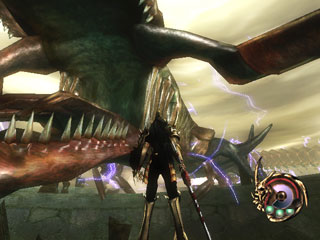 Despite
Otogi's seemingly excessive difficulty and inadequate camera system, there's
still plenty about the game to recommend it. Its true that it can be difficult
to get through certain levels without replaying them, especially early on,
putting in the effort to master the controls and intelligently equip Raikoh
opens up the game substantially. Likewise, while the boss levels seem
impossible, persistence pays off eventually. Players with the skills and
patience will find an intensely challenging action/adventure title with a lot of
depth. Players will find plenty of challenge in the game's foes as they face
massive hordes of varied and challenging enemies. The level designs are
beautiful and quite expansive, and create a dark world that never fails to
impress. There are different objectives for each level, many customizable
weapons and spells which adds to Otogi's depth and challenge. Otogi's visuals,
engine, sound and music are absolutely amazing, with some really beautiful
environments. However, Otogi: Myth of Demons appeal is more than skin-deep. Its
an excellent game the offers a surprising amount of depth and challenging title.
Otogi's good points outweigh the problems but, this isn't apparent until you
delve deeper into the game and learn to work within its limitations. For these
reasons, its an excellent game and highly recommended for Xbox owners.
Despite
Otogi's seemingly excessive difficulty and inadequate camera system, there's
still plenty about the game to recommend it. Its true that it can be difficult
to get through certain levels without replaying them, especially early on,
putting in the effort to master the controls and intelligently equip Raikoh
opens up the game substantially. Likewise, while the boss levels seem
impossible, persistence pays off eventually. Players with the skills and
patience will find an intensely challenging action/adventure title with a lot of
depth. Players will find plenty of challenge in the game's foes as they face
massive hordes of varied and challenging enemies. The level designs are
beautiful and quite expansive, and create a dark world that never fails to
impress. There are different objectives for each level, many customizable
weapons and spells which adds to Otogi's depth and challenge. Otogi's visuals,
engine, sound and music are absolutely amazing, with some really beautiful
environments. However, Otogi: Myth of Demons appeal is more than skin-deep. Its
an excellent game the offers a surprising amount of depth and challenging title.
Otogi's good points outweigh the problems but, this isn't apparent until you
delve deeper into the game and learn to work within its limitations. For these
reasons, its an excellent game and highly recommended for Xbox owners.
> Related Reviews
Panzer
Dragoon Orta (Xbox)
Gunvalkyrie (Xbox)
Jet Set Radio Future (Xbox)
Shinobi (PS2)
Gungrave (PS2)

